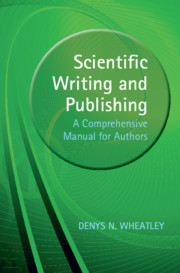Book contents
- Scientific Writing and Publishing
- Scientific Writing and Publishing
- Copyright page
- Contents
- Acknowledgements
- Introduction
- 1 General Features of a Scientific Paper
- 2 The Typical Scientific Paper
- 3 Results
- 4 Discussion
- 5 The Introduction
- 6 Materials and Methods
- 7 The Abstract
- 8 The ‘Smaller’ Sections That Complete a Paper
- 9 Figures and Tables
- 10 Presubmission
- 11 Submission of Manuscripts
- 12 Peer Review
- 13 The Last Stages of the Editorial Process
- 14 From Acceptance to Publication
- 15 Copyright
- 16 Ethics and Scientific Integrity
- 17 Epilogue
- Further Reading
- Index
2 - The Typical Scientific Paper
A Published Paper with Annotations
Published online by Cambridge University Press: 14 October 2021
- Scientific Writing and Publishing
- Scientific Writing and Publishing
- Copyright page
- Contents
- Acknowledgements
- Introduction
- 1 General Features of a Scientific Paper
- 2 The Typical Scientific Paper
- 3 Results
- 4 Discussion
- 5 The Introduction
- 6 Materials and Methods
- 7 The Abstract
- 8 The ‘Smaller’ Sections That Complete a Paper
- 9 Figures and Tables
- 10 Presubmission
- 11 Submission of Manuscripts
- 12 Peer Review
- 13 The Last Stages of the Editorial Process
- 14 From Acceptance to Publication
- 15 Copyright
- 16 Ethics and Scientific Integrity
- 17 Epilogue
- Further Reading
- Index
Summary
A published paper is presented so that the author can see how it will finally appear. Annotations are added to draw attention to many different items, particularly where the publisher will put in information pertaining to its place in the scientific literature. Fonts, sizes, columns and other layout features as well as the sequence of presentation are highlighted.
- Type
- Chapter
- Information
- Scientific Writing and PublishingA Comprehensive Manual for Authors, pp. 28 - 54Publisher: Cambridge University PressPrint publication year: 2021

